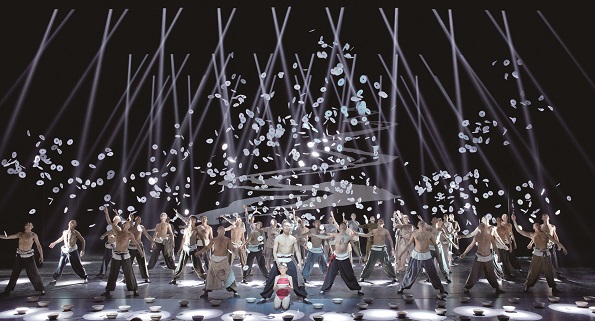By Paul Ransom of Dance Informa.
Steeped in Chinese provincial iconography and the sacrifice of war, Qingdao Song & Dance Theatre’s spectacular staging of Red Sorghum promises much more than history and perfect technique.
We are used to history wars in Australia; they form part of a lively, pluralistic cultural discourse. Yet even within the more centrally controlled context of contemporary China, the battles of (and over) the past provide fertile ground for historians and artists alike. Indeed, the ongoing Sino/Japanese spat over war shrines and rocky outcrops are testament to the deeply riven historical perspectives of East Asia’s principal powerhouses.
However, it is the still sensitive matter of Japan’s invasion of China in the 1930s that sits at the heart of Nobel Prize winning author Mo Yan’s internationally acclaimed 1986 novel Red Sorghum. Subsequently made into a Golden Bear winning film by Zhang Yimou, it is now a spectacular physical theatre production; one which will make its Australian debut in Adelaide this September as part of the OzAsia Festival.
Speaking from China, director Xu Rui explains that the balance between historical exactness and the desire to craft a compelling work of dance and acrobatics is not as tricky as one might think. “We don’t think the two are opposite,” he argues. “On the contrary, the more we desire to create a beautiful work of art, the more important it is that we know and understand the historical facts and cultural implications.”

‘Red Sorghum’ by Qingdao Song & Dance Theatre.
Aside from the political and cultural delicacy that still attaches to the Japanese occupation, the challenge of distilling the book’s epic scale into a do-able work of dance was something that the entire Qingdao Song & Dance Theatre needed to embrace. Fortunately for Xu and his ensemble, Zhang Yimou’s film had already provided a blueprint for how to do this. “A dance drama does not have enough capacity to represent a whole novel. Dance tells a story using body language. It doesn’t describe complex historical facts but shows the state of people’s living. So we chose a time period basically consistent with the film, focusing on the period when ‘my grandfather’ and ‘my grandmother’ fought against their fate.”
In other words, the most obviously dramatic and culturally loaded period of the book, as Xu further explains. “The grandparents fight is not only an individual struggle with their fate in a feudal society but also a nation’s fight against invasion and slaughter.”
Beyond the spectacle of blood and history, Red Sorghum is steeped in Chinese cultural motifs, not the least of which is the sorghum bilcolor itself. A staple crop in Shandong province, where author Mo Yan comes from, it symbolises steadfastness; impervious in the face of ephemeral drama. Its symbolic power resonates deeply with Chinese audiences, but what about Westerners?
“There is always a cultural barrier,” Xu admits. “but that is where the advantage of dance sits. We should not get entangled in the complex interpretation of words, languages and conflicts, we just need to restore the story to pure body language and feel the common emotion of human beings.”
That said, there is one other oft cited difference between the Chinese dance aesthetic and the predominantly expressive Western style. China is globally renowned for producing dancers and creating full scale productions of inch perfect technique. Although this has wowed audiences it has left many critics suggesting that Chinese dance is too militarily exact for its good.

‘Red Sorghum’ by Qingdao Song & Dance Theatre
Director Xu Rui is only too pleased to take on this notion. “The emotion of dramatic conflict is an internal support to dancing technique,” he says. “Only when the emotion is strong enough is there a desire and reason to dance. Technique exists only for expressing emotion; otherwise, it becomes pale.”
Adelaide audiences, he promises, can expect both heart and technique, not to mention the usual Chinese serving of sheer spectacle. However, Red Sorghum does not abandon its peasant Shandong roots. The production incorporates provincial folk dance traditions into its otherwise glittering sensory overload. “This is because it reflects the qualities of people living in the land of Shandong,” Xu reveals. “We integrate these qualities with the characters and emotions. At the same time, we also absorb elements of Chinese classical dance, ballet and contemporary dance in creating our new modern dance style.”
Recently awarded the Wenhau Grand Prize (the Ministry of Culture’s highest accolade for professional arts), Red Sorghum is a contemporary Chinese classic, reflecting both the emerging global confidence and deeply rooted heritage of its motherland; a heritage which , like sorghum, has proven strong enough to survive war, revolution and countless generations. Qingdao Song & Dance Theatre’s great achievement has been to maintain the ‘heritage’ of the work whilst reinvigorating it for post-millenium audiences.
For tickets and more information about Adelaide Festival Centre’s OzAsia Festival visit www.adelaidefestivalcentre.com.au/ozasia-festival

















